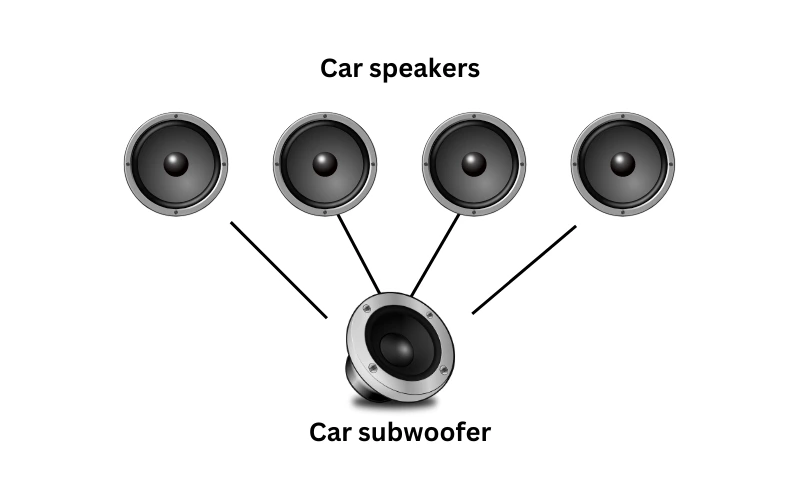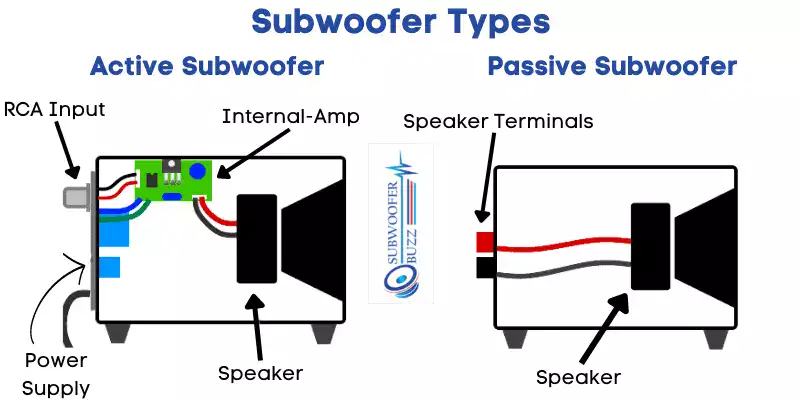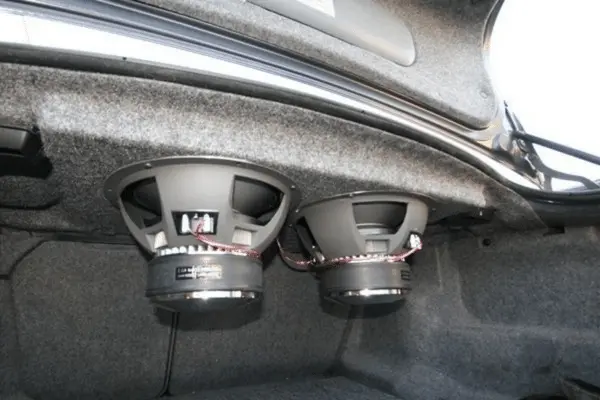What Are Subs in a Car? – Beginner’s Guide

As a beginner, it might be hard to tell what are subs in a car. However, sub is a short word for the subwoofer. On the other hand, you can also pronounce subwoofers as subs. However, if that’s not the case, you must be looking for a guide on car subwoofers. As a Car Audio technician, I will share my deep knowledge to ensure that you get the correct answer to your question regarding a car’s sub. Let’s dive in!
How Do Subwoofers Work in a Car?
If that’s the question, the answer is straightforward. Either subwoofer has a built-in amp or needs an external amp to work in the car. Moreover, subwoofers are a type of speaker designed to reproduce bass and enhance the sound quality in car stereo systems.
Subwoofers work by creating powerful low-frequency sounds that just the speaker can’t produce. When placed correctly, they provide added richness to the overall listening experience. However, a subwoofer needs good power, correct connection, placement, and enclosure to work perfectly in the car. In simple words, the subwoofer does a fantastic job of improving your overall car stereo experience.
What Are the Benefits of a Subwoofer in a Car?
A subwoofer in a car can bring a variety of benefits to your car stereo system. Just have a look at the following benefits of a car sub:
1. Bass Greater Than Regular Car Speakers:
You’ll not be amazed after knowing that subwoofers can reproduce low-frequency (deep bass response) more efficiently than just regular speakers in the car. They use more significant drivers than regular speakers and can move more air because of it, resulting in greater bass frequencies when compared to smaller speakers.
Additionally, subwoofers have a more extended excursion range, enabling them to reach lower frequencies than other types of speakers. This excursion range allows the subwoofer to deliver deeper bass with greater clarity and impact than regular speakers.
If you want to add a sub in the car, think no more and get your subwoofer right now. However, there are some things to consider before choosing the right sub.
2. Reduces Distortion in Car Sound System:
Another great feature a subwoofer can perform is reducing the overall distortion in your car’s sound system by maintaining the load on other speakers. As discussed above, a subwoofer typically features a large, dedicated woofer and external amplifier to reproduce low-frequency audio signals, such as bass lines.
By handling the lower frequency separately from the rest of the speakers in the car sound system, a subwoofer can help to reduce distortion. Focusing solely on low frequencies and having an optimized driver for those frequencies allows for more accurate sound reproduction at lower volumes.
3. Maintains Load on Other Speakers:

Besides reproducing low-frequency audio signals below the range of human hearing, it serves a vital role in any car’s audio system by helping reduce the load on the other speakers in the system by taking care of all the bass frequencies.
Doing so frees the other speakers to focus on producing higher-frequency sounds, thus providing a fuller and more balanced sound. The result is that all frequencies, from the lowest bass notes to the highest treble notes, will be accurately reproduced within your car’s audio system. This is one of the essential tasks that a subwoofer does in a car.
4. More Increased Volume:
A loud sub can reproduce the low-frequencies ranging from 200Hz to 20Hz and lower. If you add a subwoofer to your car, it can help you improve the overall audio quality of your music by providing more profound and richer low frequencies with greater volume than what small car speakers can reproduce on their own.
Additionally, if you want to listen to your music at higher volumes without sacrificing quality, adding a subwoofer can help you achieve that goal. The increased volume provided by the subwoofer is because it is specifically designed to handle low-frequency, which require more significant power than higher-frequency sounds.
5. Customization Options:
One of the significant benefits of car sub is that it provides you with many customization options. Customizing your woofer efficiently enhances audio quality while creating a unique audio experience that suits your taste and preferences. First and foremost, customizing can help you achieve higher music quality and greater power than a pre-made sub could.
By choosing what type of enclosure, external amp, wiring, and speaker size you want for your vehicle audio system, you can optimize your sound according to the requirements of your audio environment. This way, you will get the best possible performance within your budget out of your system. Another benefit of customization options for car subs is that it allows you to save space in your car.
Depending on your area and the type of sound you are looking for, customizing a subwoofer can help you fit the perfect size, shape, and weight into your car’s interior. This can help you make the most of your available space.
6. Higher Sensitivity Rating:
High sensitivity ratings ⁽¹⁾ of subwoofers in cars can bring several benefits to drivers. Firstly, they produce louder and clearer sound at low wattages so that consumers can spend less on amplifiers than subs. Secondly, the music quality produced by high-sensitivity-rated subwoofers is significantly better than the regular speakers.
This way, drivers enjoy a heightened listening experience with better bass response and sound quality. Thirdly, high sensitivity ratings of subwoofers in cars also help reduce vibrations within the car cabin, which makes for a more comfortable ride. Lastly, higher sensitivity-rated subs are much more energy efficient than lower-rated ones. This not only reduces the car’s fuel consumption but also minimizes environmental impact as well.
7. High-Quality Sound:
Besides being an essential component of the car, a subwoofer can provide high-quality sound that you’ve never experienced before. Delivering bass with greater force than traditional speakers gives the music more power and depth. Subwoofers also help improve the perceived volume level of other speakers in the car, making them sound louder and fuller.
What Are the Types of Subwoofers in Cars?
Many subwoofers are available, each designed with different capabilities, sizes, power levels, and price ranges in mind.
1. Powered Subwoofer (AKA Active):
Powered subs (also known as active subwoofers) are speaker system that includes an amplifier, crossover, and low-frequency driver built into the same cabinet. This type of subwoofer is ideal for car stereo systems because it can produce accurate and powerful bass without taking up too much space or requiring additional components.
2. Passive Subwoofer:
This sub uses external amplifiers to produce bass and other lower frequencies. A passive subwoofer allows for more customization and control of the sound frequencies, allowing the user to enjoy a fuller range of sound. This type of subwoofer also offers improved power handling capabilities compared to its active counterpart.

3. Shallow Mounted Subwoofer:
A shallow-mounted subwoofer is an audio speaker designed to fit in the limited space available in many cars. It is typically installed behind or underneath the rear seat and has a much smaller profile than conventional car subwoofers. Shallow-mounted subwoofers generally produce higher quality but with minimum energy than larger, more powerful subwoofers. They are ideal for car audio systems that require a compact and efficient sound system without sacrificing sound fidelity.
4. Free-Air Subwoofer:

A free-air subwoofer is specifically designed for car audio systems that don’t require an enclosure. The unique design of the free-air subwoofer allows it to be mounted directly to the rear deck or trunk lid of a vehicle and does not require an enclosure as traditional subwoofers do. This property makes them more space-efficient and easier to install than standard subwoofers. You can usually power such a subwoofer with an amp. It utilizes the air space inside the vehicle as its enclosure, creating a low-frequency response that can fill your car with deep bass notes.
5. Bass Tube:
A bass tube is an audio device that produces low-frequency sound (bass) in a car’s sound system. It is usually installed in the trunk or back of the vehicle and powered by an amplifier. The subwoofer uses a speaker driver to produce waves, which are then sent through tubes for better bass resonance.
6. Sealed Subwoofer:

Sealed sub comprises an enclosure that houses the subwoofer and prevents sound waves from escaping outside the vehicle, thus providing optimal quality. Sealed Subs are designed to work with very low-power amplifiers due to their high efficiency, producing deep bass notes without requiring much energy.
7. Ported or Vented Subwoofer:
A ported sub is a loudspeaker designed to provide more profound and accurate bass than its sealed counterparts. It works by creating two separate chambers for the audio, one at the back and one at the front of the speaker. This split chamber arrangement allows air to travel from the speaker’s rear to the front, creating an acoustic resonance that can improve your bass quality and electricity.
Which Sizes Does a Car Subwoofer Come In?
Car subwoofers come in various sizes, ranging from 4 to 15 inches. The size you choose largely depends on the type and size of your car’s audio system and the available space. In general, larger subwoofers produce better sound and higher bass output if connected with suitable amplifiers. However, they also need more power to drive them and take up more space in your vehicle.
- 4-Inch: These subwoofers are the smallest size you can get in a car sub. These are best for small areas such as cabinets or tight spaces under the seat of your car. They also require less power than larger subwoofers, so they’re easy to install.
- 8-Inch: Such subwoofers are the most common size for car subwoofers and provide an outstanding balance between sound and power consumption. They also take up relatively little space in your vehicle, making them an ideal choice for most cars.
- 10-Inch: These subwoofers substantially increase music quality and bass output compared to eight-inch subwoofers. They also require more energy to drive them, so you may need to upgrade your car stereo system to use this subwoofer size.
- 12-Inch: Such subwoofers are the next step up in quality and bass output. They require even more power than ten-inch subwoofers, so you may need to upgrade your car audio system or add an amplifier to use this subwoofer size.
- 15-Inch: The largest size available for car subwoofers and offers the best sound waves and bass output. They require a lot of energy to drive them, so you may need a powerful amplifier for your car’s audio system to use this subwoofer.
How to Choose a Subwoofer for Your Car?
You need to be very careful regarding choosing a car subwoofer. Choosing the right subwoofer for your vehicle requires considering several factors, including sensitivity, power handling, enclosure type, and size.
- Sensitivity: It measures how efficiently a subwoofer converts power into sound. Car subs with higher sensitivity ratings are more efficient and use less energy. They also tend to perform better than those with lower ratings, making them a better choice for cars with limited capacity.
- Power Handling: The amount of electricity a subwoofer can handle will impact its performance. A subwoofer with a higher handling rating can take more volume without being overdriven. If you plan on playing your music loud, then it’s essential to choose a subwoofer that can handle the energy output of your amp.
- Enclosure Type: The type of enclosure you choose for your subwoofer will also affect its performance. An enclosed subwoofer is sealed in a box, usually made from wood or fiberglass. This type of enclosure helps to increase the subwoofer’s efficiency and keeps it sounding good at higher volumes.
- Size: The size of your sub is also essential when choosing the right one for your car. Your subwoofer’s wideness will determine how much space it takes up in your vehicle and its power-handling capacity. Generally, larger subwoofers can handle more energy than smaller ones and produce deeper bass notes.
General FAQs
How Much Is a Sub in a Car?
The cost of a subwoofer in a car can vary depending on several factors:
1. The type of material used to construct it will affect the price. Subs made from MDF (Medium Density Fiberboard) tend to be more expensive than those made of plastic or other materials.
2. The size and energy of the subwoofer will also influence its cost. A larger and more powerful subwoofer will naturally be more expensive than a smaller one.
3. The brand and quality of the subwoofer can also affect its price; higher-end brands with superior sound tend to be pricier than less expensive models.
What Does It Mean to Put Subs in Your Car?
Adding subwoofers (or subs) to your vehicle is an easy way to improve your audio system’s music quality significantly. Subs are designed to handle low-frequency sounds, so they do an excellent job of making bass notes and drums frequency more accurate and robust. In addition, adding subs helps bring out the clarity in other frequencies, making all of your music sound better.
What Is the Sensitivity in a Car Subwoofer?
Sensitivity is a measure of how loud the sound output from a car sub will be when a given amount of energy is applied. Generally speaking, if two car subwoofers have the same sensitivity rating, they will produce the same volume level for any given amplifier power setting.
The higher the sensitivity rating, the louder the subwoofer will be. The sensitivity of a car subwoofer is usually measured in decibels (dB) and is typically printed on the back of the box. A higher number means more sound for less power, so if you’re looking for a powerful-sounding subwoofer with plenty of punch, look for one with a high sensitivity rating.
